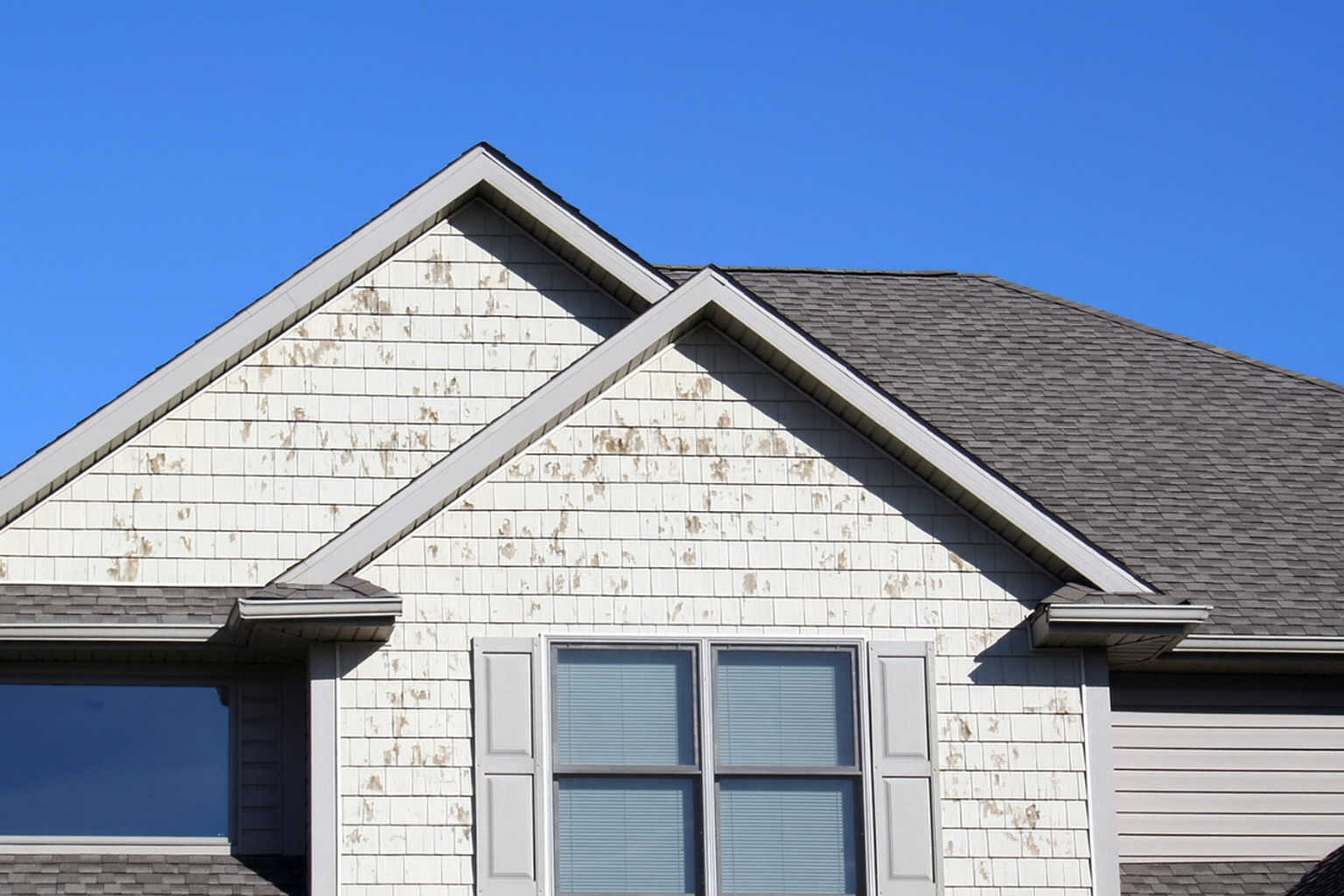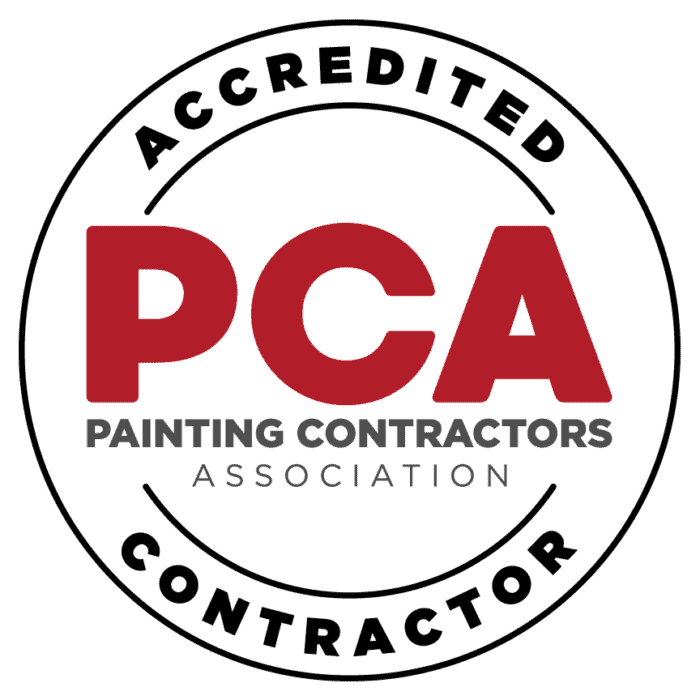Chipped or peeling paint is more than just an eyesore. It can signal deeper issues like moisture damage, poor prep work, or even hidden lead paint.
If you’ve been searching for how to repair chipped paint in your Erie, CO home or business, you’re not alone. Paint chips show up on walls, trim, bathroom ceilings, window sills, and even on cars and knowing why it happens is just as important as fixing it.
We work with homeowners every day who are frustrated by paint that doesn’t hold up. Whether it’s chipped drywall in a living room, peeling enamel paint on wood trim, or rust showing through chipped car paint, we’ve seen it all.
Let’s break down what really causes chipped paint, the tools professionals use, and why fixing it right matters.
Key Takeaways:
- Chipped paint is often caused by moisture, poor prep, or daily wear on walls, trim, and drywall.
- Professional repair includes scraping, sanding, filling, priming, and repainting for a seamless finish.
- Bathrooms and kitchens are common areas for peeling paint due to humidity and lack of waterproofing.
- Primer plays a critical role in making repairs last and preventing future peeling.
Why Chipped Paint Happens
Paint doesn’t just fall apart for no reason. Here are some of the most common causes we find in homes around Erie:
- Moisture and leaks: Bathrooms, kitchens, and basements are notorious for chipped or peeling paint because water sneaks under the surface. Even a tiny leak behind drywall or near a window frame can make paint bubble, chip, and peel.
- Poor prep work: Skipping primer, not sanding properly, or painting over dust can all cause paint failure. That’s why knowing about coats of primer is so important.
- Old layers of lead paint: In homes built before 1978, chipped areas may expose lead-based paint. This isn’t just unattractive — it’s unsafe, especially around children.
- Heat and pressure changes: High heat near stoves or bathrooms without proper waterproofing can cause latex or oil paint to crack.
- Everyday wear and tear: Furniture scraping walls, kids’ toys hitting baseboards, or even pets can all cause small chips.
The Right Tools and Materials
When professional painters repair chipped paint, they don’t guess at what works. They use specific tools and products to get a smooth finish.
Common tools and materials include:
- Putty knife or scraper
- Wire brush or razor scraper
- Sandpaper or sanding sponge
- Spackling paste or joint compound
- Wood putty for trim and doors
- Primer (latex or oil-based depending on the surface)
- Quality paintbrush or spray paint applicator
- Masking tape and plastic to protect surrounding areas
For tougher surfaces, a wire brush or even a polishing wheel may be used to smooth rusted metal before applying enamel paint. On drywall, a thin layer of joint compound makes the wall even again.
Step-By-Step: How to Repair Chipped Paint
While there are plenty of articles out there about how to repair chipped paint, the truth is that long-lasting results depend on prep, patience, and experience. Here’s what we do:
- Scrape away loose paint. A scraper or razor tool removes flaking edges without gouging the wood, drywall, or plaster.
- Sand the area. Fine-grit sandpaper smooths sharp edges. On larger areas, sanding machines help flatten the surface.
- Clean and dust. Dust, rust, or adhesive left behind will ruin new paint. Wiping with a damp cloth or using a wire brush is standard practice.
- Fill the chip. For walls, spackling paste or joint compound is applied with a putty knife. For trim or wood, a tougher wood filler or putty is used.
- Sand again. Once dry, the filled area is sanded flush so the repair blends seamlessly into the surrounding paint.
- Prime the surface. A fresh coat of primer prevents future peeling and helps the repaired spot absorb paint evenly.
- Paint to match. A high-quality brush, roller, or sprayer finishes the job. Professionals use the right sheen (matte, satin, enamel) depending on the surface.
Interior vs. Exterior Paint Chips
Chipped paint isn’t the same indoors and outdoors. Erie’s weather swings — freezing winters, hot summers, hail, and heavy moisture — can wreak havoc on exterior paint. That’s why it’s smart to learn about weather mistakes when painting your house exterior before scheduling your next project.
- Interior paint chips: Often caused by humidity, poor prep, or scratches. Common in bathrooms, kitchens, and kids’ rooms.
- Exterior paint chips: Usually linked to harsh sun, water intrusion, or applying the wrong type of paint without waterproofing.
- Knowing the difference helps professional painters choose the right fix, like enamel paint for trim or latex paint for interior walls.
Safety Matters: The Risk of Lead Paint
One topic that can’t be ignored is lead. Chipped paint in older homes may expose lead paint, which produces hazardous dust when sanded. This is not something to brush off. Professional painters in Erie, CO are trained to safely handle and contain lead-based paint so your family isn’t at risk.
Why Hiring Professional Painters in Erie, CO Makes Sense
At first glance, chipped paint looks like a small issue. But as professionals, we see it differently. Small chips often grow into bigger problems — hidden water damage, spreading rust, or exposed lead dust. The right fix requires more than a brush and a can of paint.
That’s where experience matters. Our team has worked with every kind of surface: wood, drywall, plaster, trim, and even tricky enamel finishes. We don’t just patch. We solve the root problem so the new finish lasts.
If you’re thinking about repainting more than just a patch, it might help to read about signs to repaint your house exterior or even use our paint calculator to estimate how much paint you’ll really need.
Keeping Your Erie, CO Home Looking Its Best with Lasting Paint Repairs
Knowing how to repair chipped paint is one thing. Making sure it’s done right, with the right tools, materials, and expertise, is what keeps your home looking sharp for the long run. Chipped or peeling paint can be frustrating, but with the help of professional painters in Erie, CO, you can protect your walls, trim, and exterior surfaces while improving the overall look of your home.
At A New View Painting, here’s how we handle paint repairs and repainting:
- Inspect the surface for hidden causes like leaks, dust, or rust
- Safely scrape and sand chipped areas
- Apply spackling paste, putty, or joint compound to fill chips
- Prime the surface to prevent peeling
- Finish with high-quality paint suited to each room or exterior surface
If you live in Boulder, Longmont, Frederick, or the surrounding Colorado areas, call us at 970-660-3993 for a FREE estimate. Our team is ready to restore your home’s walls and exterior so they look fresh, smooth, and built to last.
FAQs About Repairing Chipped Paint in Your Home
How do you fix chipped paint on a wall?
Professional painters scrape away the loose paint, sand the area smooth, fill with spackling paste or joint compound, sand again, apply primer, and then repaint so the repair blends in with the rest of the wall.
What causes paint to peel in a bathroom?
High humidity, poor ventilation, and skipped waterproofing steps are the most common culprits. Moisture gets behind the latex or enamel paint, causing it to lose adhesion.
Can chipped paint be repaired without repainting the whole wall?
Yes. Small sections can be repaired and painted to match. However, if the wall has multiple chips or fading, repainting the full surface often provides a cleaner, longer-lasting result.
Do you need primer after repairing chipped paint?
Absolutely. Primer seals the patched area and helps the topcoat stick evenly. Skipping primer can lead to new chips and uneven finish — this is why knowing about coats of primer is so important.
How long does a chipped paint repair last?
When the repair is done correctly with the right prep, primer, and paint, it should last for years. The key is addressing the root cause — whether that’s moisture, dust, or improper prep.





